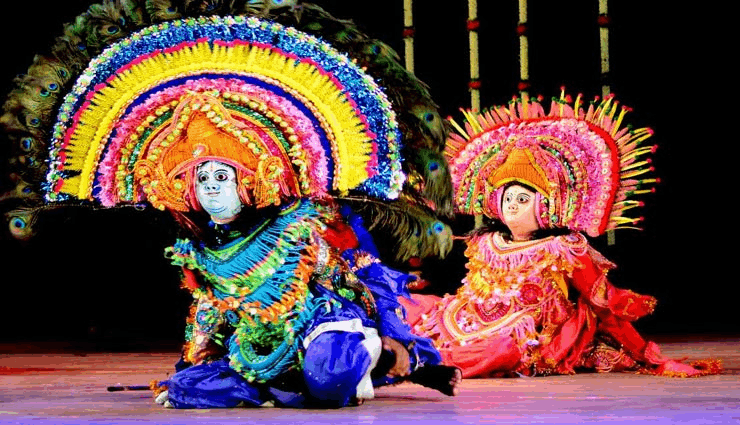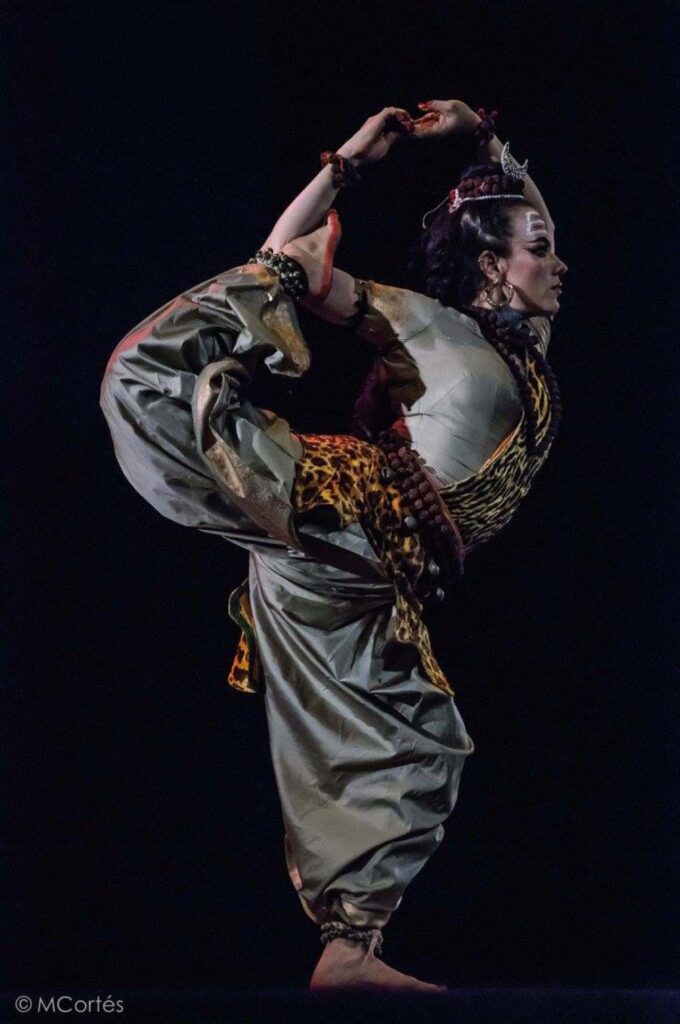Dancers strive to keep Chhau traditions alive in India

Dancers from the Purulia district of West Bengal perform Chhau in the iconic Purulia masks (Photo: Digantatalukdar)
Chhau dance is an Indian tribal martial dance that originated in the states of Odisha, West Bengal, and Jharkhand. Mayurbhanj Chhau (Odisha) and Purulia Chhau (West Bengal) are the more well known sub-genres, and integrate martial, acrobatic and athletic styles to celebrate religious themes and ancient traditions of folk people in India.
Carolina Prada has been learning Chhau under Sangeet Natak Academy awardee Guru Janmejoy Saibabu since 2008, when she migrated from Colombia to India, specifically to train in Odissi and Chhau dance. One of the few female soloists of this generation to research, choreograph and perform at a professional level in Mayurbhanj Chhau, Prada has received critical acclaim for her performances in national and international dance festivals.
“I had always practiced and liked the martial interpretation and style of dances. I had watched some Chhau videos before and was really impressed and interested, so I made it a point to look out for it when I came,” Prada tells Media India Group.
Since many Indians are not familiar with Chhau, Prada explains that there were some boundaries in the beginning as she attempted to pursue a professional career in the field.
“It posed a bit of a challenge because we don’t get as much exposure as the other dance forms. More importantly, its pure form has not been so recognised, as Chhau is often taken as something complementary to contemporary dance or just mixed with other styles or acrobatic movements. It actually has an ample variety of movements and techniques, which are very rich and varied and can require many years of mastering it. Many people don’t understand or value it properly,” says Prada.
Although the dance traditionally consisted of an all-male troupe, females have also begun to establish themselves as skilful artists. Prada credits her confidence and ability to challenge these limits to her Guru, who made sure to teach her male styles from the very beginning, therefore bringing her to an equal playing field when it came to performing.
“The quality of your performance doesn’t depend on the gender. And just because I’m a woman, it doesn’t mean I do a modified form with less jumping or technique. Many people, especially choreographers, often say, ‘of course we need a male Arjuna, why would we use a female?’” says Prada, adding “But somehow I’ve gotten the chance to challenge this gender stereotype many times. We danced at the Khajuraho Dance Festival in 2019, and I played a male character along with 10 other boys.”
Stories told through Chhau dance
What sets Chhau apart from other classical dance forms are the stories that are told though the dance performances. Sunil Mehra, a Delhi-based Mayurbhanj Chhau dance artist, has also trained under Guru Shri Janmejoy Sai Babu for the last decade, and was introduced to Chhau by his father. As a child, Mehra was fascinated by the strength and expression required in the movements.
“Its creativity lies in its origin. What makes it more interesting and beautiful is that an artist who performs [folk-style] Chhau Dance tells all the movements of a layman’s normal routine. Isn’t it so simple yet so imaginative?” wonders Mehra.
These social items depict small-town Indian traditions that have persevered through generations, how the fishermen go to the sea and catch fish or how farmers cultivate crops during harvest season. Some represent ancient traditions such as wife-choosing ceremonies or a male’s extravagant mating dance to win over his fiancé.
Embodying Indian Mythology

Prada performing Mayurbhanj Chhau (Photo: Maria Conchita Cortés)
Another popular style in the Chhau repertoire are the “pure dances” from the Nritya component, which includes martial dances like the war dance known as ‘Ruk Mar,’ which does not depict a story, but shows the use of the martial attack and defence movements. The most famous items are based on mythological stories, produced as mini dance dramas of characters in Ramayan and Mahabharat, or isolated items based on the characters of the goddess Durga, Lord Shiva or Garuda Vahana.
These themes are especially popular in West Bengal, where large, elaborately designed masks and headgear are a characteristic part of the performance, known as Purulia Chhau. The beautiful and exceptional designs have put Purulia Chhau dance on UNESCO’s list of world heritage dances, and was featured in a big way in the hit Bollywood film Barfi (2012). These intricate masks are painstakingly made in several stages by artists of the Sutradhar community, using a combination of clay, mud and cloth.
Mayurbhanj Chhau does not use masks, so dancers rely on facial expressions and movements to convey emotion, and employ techniques similar to method acting. For Prada, this is a big attraction of performing Chhau as she fondly remembers playing Lord Shiva as one of her most iconic roles.
“Lord Shiva is my favourite character to play, and also one of the most challenging. Not just because the body language and movements are difficult and a lot of flexibility is needed to perform this, but especially because of the amount of energy you need to imbibe. Unlike in other classical dance forms where you are just selling the story, in Chhau you have to become the character. For me this item makes me face all kinds of emotions and look at myself in the mirror to see how much in tune I am with that energy, how much I can transcend this world and belong in that state of mind with Lord Shiva,” she explains.
Prada explains that Chhau has become her passion and calling in life, and along with her Guruji, she strives to make it more well known in India and across the world.
“That has always been one of my motives. Through my blog or my Instagram, people can see how Chhau is portrayed in different ways. I also have an advantage in my own experience, as being a foreigner I can understand how to make it more approachable to people who are completely new to Indian classical dance,” she says.
Sharma also finds it important to use his social media to spread awareness about Chhau.
“It does not get its due. As an artist, I try to do my level best to promote this dance form amongst not only artists but also young kids by taking workshops in various schools and taking online dance classes so that the kids who are the future of our country get to know about the legacy of Chhau. Nowadays, a lot of awareness can be created through social media handles so many artists like me are creating posts and taking classes just to grab a chance to make people aware of this beautiful dance form.”









